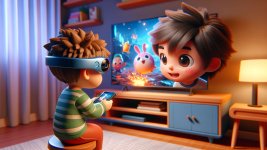Children are naturally drawn to color, movement, and fun. Traditional teaching methods often struggle to capture their short attention spans and varied learning styles. That’s where animated educational tools come in—leveraging computer graphics and motion design to transform learning into a playful, immersive, and effective experience.
From interactive alphabet games to animated science labs and gamified math problems, animation in children’s education is no longer just a trend—it’s a powerful pedagogical strategy.
Animated characters, dynamic visuals, and colorful environments keep children glued to the screen. The engaging nature of animation helps reduce distraction and boost focus, even in hyperactive learners.
Complex ideas—like gravity, multiplication, or plant growth—become easier to grasp when shown visually. Motion graphics break down step-by-step processes that kids might struggle to visualize with text alone.
Interactive animations allow children to tap, drag, and explore. This hands-on experience improves retention and understanding, encouraging independent learning.
Characters with personalities and expressions create a connection. When a cartoon dog cheers them on for solving a puzzle, children feel encouraged and supported, increasing their motivation to learn.
Used in storytelling, phonics apps, and vocabulary games. 2D is cost-effective and often enough for simple, fun learning tools.
Used in science apps or simulation-based games for a more immersive experience, like exploring the solar system or the inside of the human body.
Often combined with narration to explain historical events or science concepts in engaging bite-sized videos.
Incorporate challenges, points, and rewards to keep children motivated and encourage repetition-based learning.
With emerging technologies like AI-generated voices, adaptive learning, and augmented reality, the next generation of animated tools will be more personalized, interactive, and intuitive. These tools will not just teach—they will respond to a child's learning pace, behavior, and even emotional cues.
Do you think animated tools are more effective than textbooks for children?
What animated app or game helped your child (or you) learn better?
How do you see animation shaping the future of early education?
Let us know your thoughts in the comments!
From interactive alphabet games to animated science labs and gamified math problems, animation in children’s education is no longer just a trend—it’s a powerful pedagogical strategy.
The Power of Animation in Early Education
1.
Animated characters, dynamic visuals, and colorful environments keep children glued to the screen. The engaging nature of animation helps reduce distraction and boost focus, even in hyperactive learners.
2.
Complex ideas—like gravity, multiplication, or plant growth—become easier to grasp when shown visually. Motion graphics break down step-by-step processes that kids might struggle to visualize with text alone.
3.
Interactive animations allow children to tap, drag, and explore. This hands-on experience improves retention and understanding, encouraging independent learning.
4.
Characters with personalities and expressions create a connection. When a cartoon dog cheers them on for solving a puzzle, children feel encouraged and supported, increasing their motivation to learn.
Techniques Behind Animated Educational Tools
● 2D Animation
Used in storytelling, phonics apps, and vocabulary games. 2D is cost-effective and often enough for simple, fun learning tools.
● 3D Animation
Used in science apps or simulation-based games for a more immersive experience, like exploring the solar system or the inside of the human body.
● Stop-Motion and Motion Graphics
Often combined with narration to explain historical events or science concepts in engaging bite-sized videos.
● Game-Based Animations
Incorporate challenges, points, and rewards to keep children motivated and encourage repetition-based learning.
Tools Commonly Used
- Toon Boom & Adobe Animate: For 2D educational animations.
- Unity & Unreal Engine: To create interactive learning games.
- Blender & Maya: For 3D educational visuals.
- Scratch (by MIT): A child-friendly tool for creating simple animated projects.
- Powtoon & Vyond: Quick platforms for creating animated explainer videos.
Case Studies & Real-World Examples
- Khan Academy Kids: Uses animated characters and storylines for early literacy and math.
- ABCmouse: Offers over 10,000 learning activities with colorful 2D animations.
- Duolingo ABC: Teaches children to read through interactive animated lessons.
- Toca Boca: An app series using animation to simulate daily life scenarios for children.
Challenges and Considerations
- Cultural Sensitivity: Graphics and characters should reflect diverse backgrounds.
- Balance with Screen Time: While animations are engaging, moderation is important.
- Accessibility: Tools should support audio narration, subtitles, and simple controls for children with different learning needs.
- Pedagogical Alignment: Animation must serve learning objectives, not just entertainment.
Future of Animated Learning Tools
With emerging technologies like AI-generated voices, adaptive learning, and augmented reality, the next generation of animated tools will be more personalized, interactive, and intuitive. These tools will not just teach—they will respond to a child's learning pace, behavior, and even emotional cues.
Join the Conversation
Do you think animated tools are more effective than textbooks for children?
What animated app or game helped your child (or you) learn better?
How do you see animation shaping the future of early education?
Let us know your thoughts in the comments!

